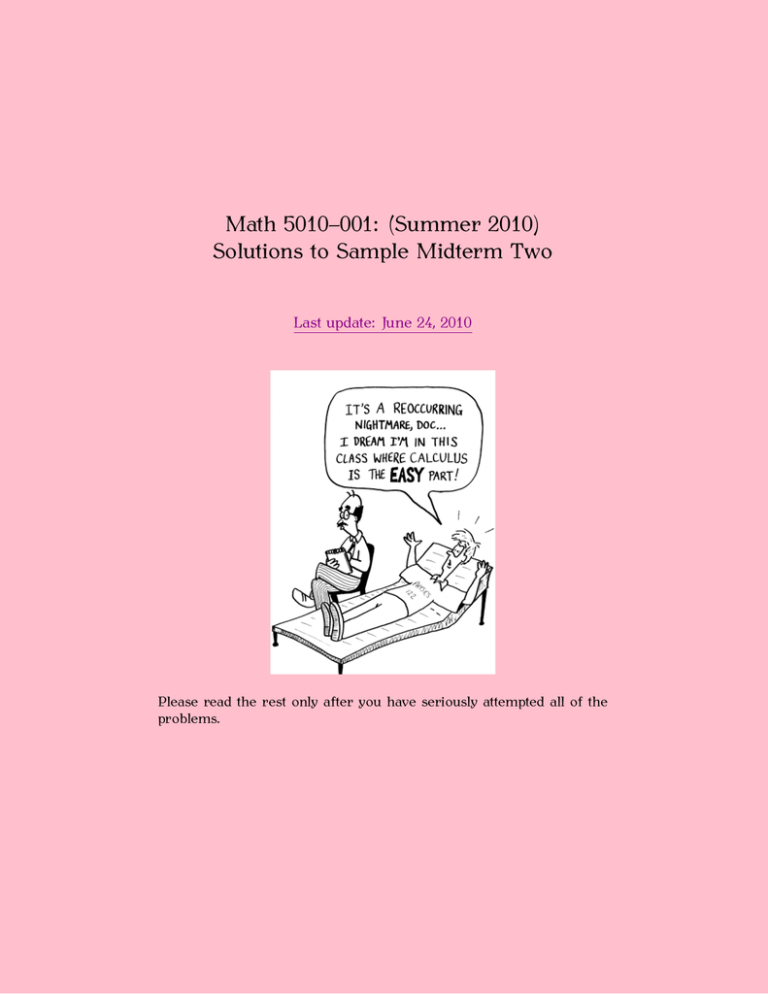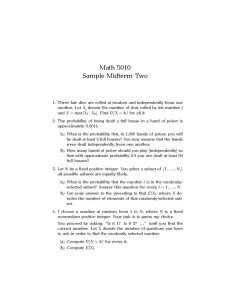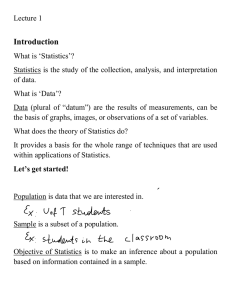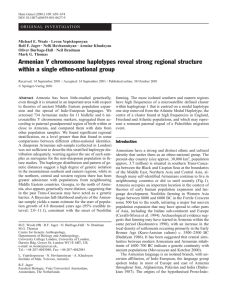Math 5010–001: (Summer 2010) Solutions to Sample Midterm Two Last update:
advertisement

Math 5010–001: (Summer 2010)
Solutions to Sample Midterm Two
Last update: June 24, 2010
Please read the rest only after you have seriously attempted all of the
problems.
1. Two fair dice are rolled at random and independently from one
another. Let Xj denote the number of dots rolled by die number j
and X = max(X1 , X2 ). Find P{X = k} for all k.
Solution: The possible values of X are 1,. . . ,6. This leads us to the
following table of probabilities:
Possible value
1
2
3
4
5
6
2
Probability
1/36
3/36
5/36
7/36
9/36
11/36
2. The probability of being dealt a full house in a hand of poker is
approximately 0.0014.
(a) What is the probability that, in 1,000 hands of poker, you will
be dealt at least 2 full houses? You may assume that the hands
were dealt independently from one another.
(b) How many hands of poker should you play [independently] so
that with approximate probability 0.5 you are dealt at least 50
full houses?
Solution to (a):
1000
1000
1000
999
1−
0.9986
+
0.0014 × 0.9986
≈ 0.4087475.
0
1
Solution to (b): Let n denote the number of hands needed. Let X
be a Binomial(n , 0.0014). Then we want n so √
that P{X ≥ 50} ≈ 0.5.
Normal approximation [µ = 0.0014n and σ = 0.0014 × 0.9986 × n]
tells us that
50 − µ
0.5 ≈ P{X ≥ 50} ≈ 1 − Φ
.
σ
Therefore, we want µ = 50, whence n = 50/0.0014 ≈ 35714.286.
That is, we need n ≥ 35715.
3
3. Let N be a fixed positive integer. You select a subset of {1 , . . . , N},
all possible subsets are equally likely.
(a) What is the probability that the number i is in the randomlyselected subset? Answer this question for every i = 1, . . . , N.
(b) Use your answer to the preceding to find E(X), where X denotes the number of elements of that randomly-selected subset.
Solution to (a): There are 2N subsets; 2N−1 of them do not have
the number i in them; therefore 2N − 2N−1 = 2N−1 of them have
the number i in them. Consequently,
P {the number i is in the random subset} =
2N−1
1
= .
N
2
2
Solution to (b): Let Ai denote the event that i is in the subset. Then
IA1 + · · · + IAn is the number of elements in the random subset. I.e.,
X. It follows that
E(X) = P(A1 ) + · · · + P(AN ) =
4
N
.
2
4. I choose a number at random from 1 to N, where N is a fixed
nonrandom positive integer. Your task is to guess my choice. You
proceed by asking: “Is it 1? Is it 2? . . . ” until you find the correct
number. Let X denote the number of questions you have to ask in
order to find the randomly selected number.
(a) Compute P{X = k} for every k.
(b) Compute E(X).
Solution to (a): Some thought shows that X is the number that I
chose. Therefore, P{X = k} = 1/N if k = 1, . . . , N.
Solution to (b): From part (a) and the examples worked out during
lecture,
1 + ··· + N
N +1
E(X) =
=
.
N
2
Good luck on Monday. And see you in a week.
5






